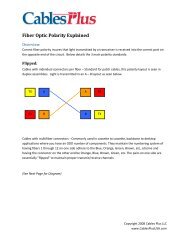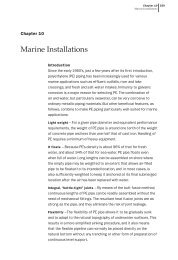Learning About Options in Fiber - Cables Plus USA
Learning About Options in Fiber - Cables Plus USA
Learning About Options in Fiber - Cables Plus USA
You also want an ePaper? Increase the reach of your titles
YUMPU automatically turns print PDFs into web optimized ePapers that Google loves.
ema<strong>in</strong>s at the <strong>in</strong>dustry standard of 125 microns<br />
for purposes of connect<strong>in</strong>g and splic<strong>in</strong>g.<br />
With only one mode it is easier to ma<strong>in</strong>ta<strong>in</strong> the<br />
<strong>in</strong>tegrity of each light pulse. The pulses can be<br />
packed much more closely together <strong>in</strong> time, giv<strong>in</strong>g<br />
s<strong>in</strong>gle-mode fiber much larger channel capacity.<br />
Refer to section 3, References, Tables A and B for<br />
charts offer<strong>in</strong>g fiber comparisons.<br />
SECTION 2—FIBER-OPTIC BASICS<br />
Material Dispersion<br />
Different wavelengths (colors) also travel at different<br />
velocities through a fiber, even <strong>in</strong> the same mode<br />
(refer to earlier discussions on Index of Refraction).<br />
Each wavelength, however, travels at a different<br />
speed through a material, so the <strong>in</strong>dex of refraction<br />
changes accord<strong>in</strong>g to wavelength. This phenomenon<br />
is called material dispersion s<strong>in</strong>ce it<br />
arises from the material properties of the fiber.<br />
DISPERSION<br />
Dispersion is the spread<strong>in</strong>g of a light pulse as it<br />
travels down the length of an optical fiber. Dispersion<br />
limits the bandwidth (or <strong>in</strong>formation-carry<strong>in</strong>g capacity)<br />
of a fiber. There are three ma<strong>in</strong> types of dispersion:<br />
Modal, material, and waveguide.<br />
Modal Dispersion<br />
Modal dispersion occurs only <strong>in</strong> multimode fiber.<br />
Multimode fiber has a core diameter <strong>in</strong> the 50-µm<br />
to more than 1000-µm range. The large core<br />
allows many modes of light propagation. S<strong>in</strong>ce<br />
light reflects differently for different modes, some<br />
rays follow longer paths than others. (Refer to<br />
page 2-3, Figures 2-3, 2-4 and 2-5.)<br />
The lowest order mode, the axial ray travel<strong>in</strong>g<br />
down the center of the fiber without reflect<strong>in</strong>g,<br />
arrives at the end of the fiber before the higher<br />
order modes that strike the core-to-cladd<strong>in</strong>g <strong>in</strong>terface<br />
at close to the critical angle and, therefore,<br />
follow longer paths.<br />
Thus, a narrow pulse of light spreads out as it<br />
travels through the fiber. This spread<strong>in</strong>g of a light<br />
pulse is called modal dispersion. There are three<br />
ways to limit modal dispersion:<br />
• Use s<strong>in</strong>gle-mode fiber s<strong>in</strong>ce its core diameter<br />
is small enough that the fiber propagates only<br />
one mode efficiently.<br />
• Use a graded-<strong>in</strong>dex fiber so that the light rays<br />
that follow longer paths also travel at a faster<br />
average velocity and thereby arrive at the<br />
other end of the fiber at nearly the same time<br />
as rays that follow shorter paths.<br />
• Use a smaller core diameter, which allows<br />
fewer modes.<br />
Material dispersion is of greater concern <strong>in</strong> s<strong>in</strong>glemode<br />
systems. In multimode systems, modal dispersion<br />
is usually significant enough that material<br />
dispersion is not a problem<br />
Waveguide Dispersion<br />
Waveguide dispersion, most significant <strong>in</strong> a s<strong>in</strong>glemode<br />
fiber, occurs because optical energy travels<br />
at slightly different speeds <strong>in</strong> the core and<br />
cladd<strong>in</strong>g. This is because of the slightly different<br />
refractive <strong>in</strong>dices of the materials.<br />
Alter<strong>in</strong>g the <strong>in</strong>ternal structure of the fiber allows<br />
waveguide dispersion to be substantially<br />
changed, thus chang<strong>in</strong>g the specified overall dispersion<br />
of the fiber.<br />
BANDWIDTH VS. DISPERSION<br />
Manufacturers of multimode offer<strong>in</strong>gs frequently<br />
do not specify dispersion, rather they specify a<br />
measurement called bandwidth (which is given <strong>in</strong><br />
megahertz/kilometers).<br />
For example, a bandwidth of 400 MHz/km means<br />
that a 400-MHz signal can be transmitted for 1 km.<br />
It also means that the product of the frequency<br />
and the length must be 400 or less (BW x L =<br />
400). In other words, you can send a lower frequency<br />
a longer distance: 200 MHz for 2 km; 100<br />
MHz for 4 km; or 50 MHz for 8 km.<br />
Conversely, a higher frequency can be sent a<br />
shorter distance: 600 MHz for 0.66 km; 800 MHz<br />
for 0.50 km; or 1000 MHz for 0.25 km<br />
S<strong>in</strong>gle-mode fibers, on the other hand, are specified<br />
by dispersion. This measurement is expressed<br />
<strong>in</strong> picoseconds per kilometer per nanometer of<br />
source spectral width (ps/km/nm).<br />
In other words, for s<strong>in</strong>gle-mode fiber dispersion is<br />
2-5
















